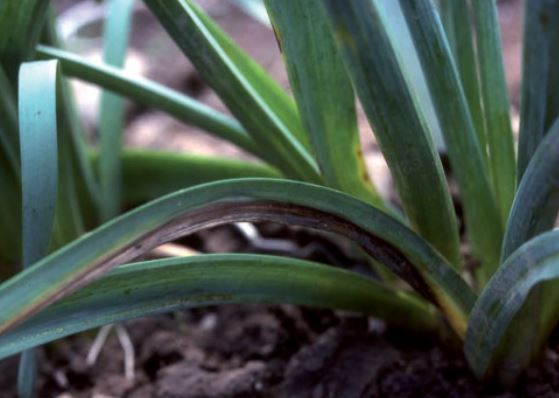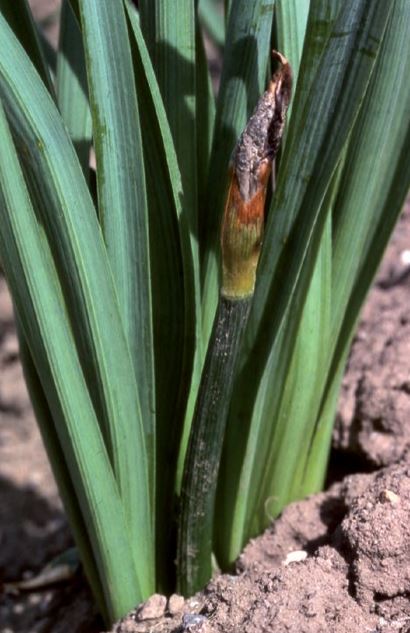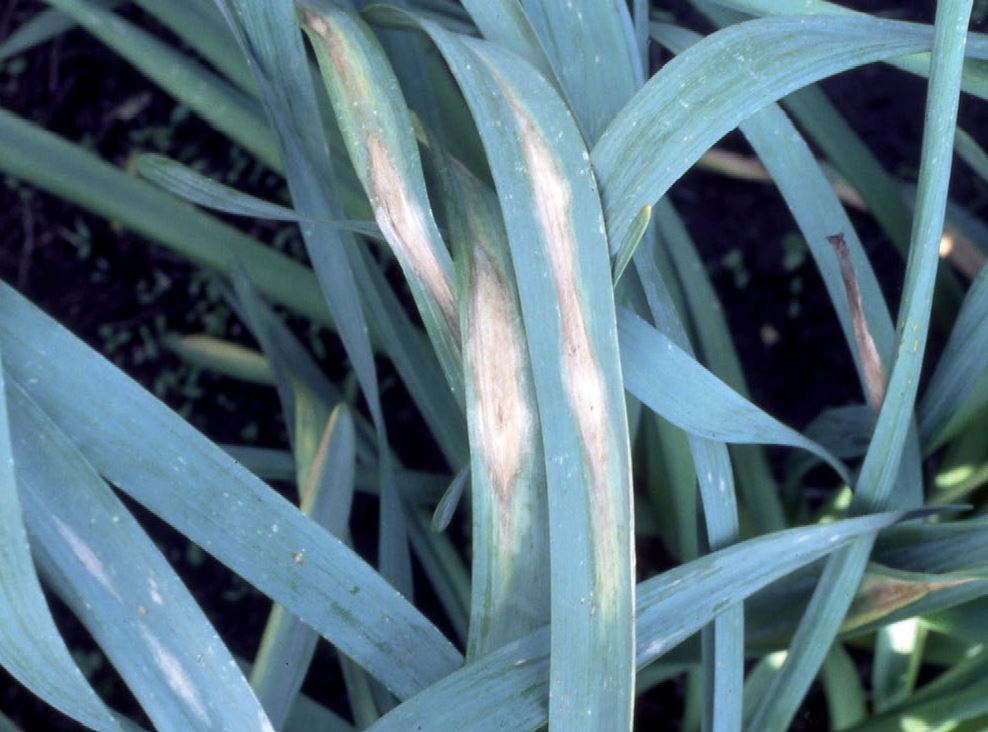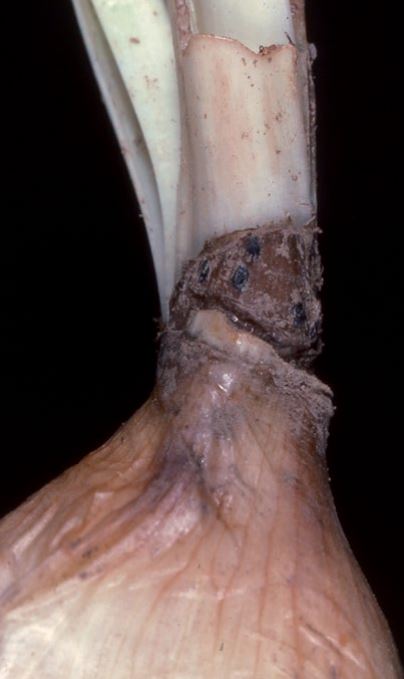Please click here to access the main AHDB website and other sectors.
- Home
- Knowledge library
- Narcissus smoulder: symptoms, spread and disease development
Narcissus smoulder: symptoms, spread and disease development
Read on for information on the biology of smoulder its symptom expression and development in narcissus.
The information was last updated in 2016.
Go back to the main page: Narcissus leaf scorch, smoulder and white mould
Smoulder is common wherever narcissus is grown. Generally, the disease is present at relatively low levels and develops quite slowly but occasionally, especially in cool wet seasons, it can spread through a crop. Effective management of the disease can prevent premature leaf dieback and greatly reduced bulb yields.
Spotting the symptoms
Smoulder is a fungal disease caused by Botryotinia narcissicola (usually present as, and known by, its asexual stage, Botrytis narcissicola).
Botrytis cinerea is also sometimes recovered from narcissus, though experimental work shows it is considerably less pathogenic to the crop than B. narcissicola, and probably occurs mainly as a saprophyte (an organism that lives on dead or decaying organic matter).
The initial symptoms of smoulder are dark brown-black leaf tips on emerging shoots in the spring.
These primaries often have their leaf tips withered, distorted, adhering and blackened.
Humidity
In humid weather, affected tissues are covered in a grey, furry sporing mass of the causal fungus.
Later, other leaves develop dark brown lesions surrounded by yellowing areas.
These lesions may occur at the leaf tip or on one side of a leaf, the latter resulting in characteristic sickle-shaped lesions (see figure 1).
 ADAS
ADAS
Figure 1. A sickle-shaped smoulder lesion with a black sclerotium visible
Brown lesions
Flower buds may develop brown lesions and open flowers may develop spotting (see figure 2).
Further lesions may develop after flowering especially where the leaf flexes and cracks. These lesions, which arise from air blown or water splashed spores, are pale brown, oval and large (20–30 by 10–15mm). See Figure 3.
 ADAS
ADAS
Figure 2. Flower bud decay due to smoulder
 ADAS
ADAS
Figure 3. Botrytis narcissicola can result in large pale-brown oval lesions in wet weather
Leaf dieback
In wet weather, they may spread and merge leading to early leaf dieback, which can easily be mistaken for natural leaf senescence.
Also at this time, a stalk end rot may develop after flower picking, from the cut end downwards.
As with leaf lesions, in humid weather flower stalk end rots are likely to develop the grey sporulation typical of Botrytis.
As the leaves die back, the fungus grows down into the bulb neck (see figure 4).
Soil level
Sclerotia may form at soil level in the base of rotting shoots, in the bulb neck and in leaf debris on the ground.
In experimental work, reduction of dieback from smoulder by the use of fungicides has resulted in prolonged retention of green leaves and flower stalks and large increases in bulb yield.
 ADAS
ADAS
Figure 4. B. narcissicola sclerotia visible in old leaf bases in the bulb neck
Sources and spread
The main source of smoulder is infected bulbs, where Botrytis narcissicola occurs as fungal mycelium in the bulb neck and as black resting bodies (sclerotia, around 1–3mm by 1–2mm in size) in the neck and outer papery scales.
Leaves become infected as they emerge through the bulb neck, resulting in ‘primary’ infector plants seen early in a season.
Experimental work has demonstrated that sclerotia of B. narcissicola in leaf debris and in the soil can result in primary symptoms as shoots push through infested soil.
Cool and wet
When conditions are favourable (cool and wet), B. narcissicola sporulates profusely on leaf, flower bud and flower stalk lesions and the spores (conidia) are dispersed by wind and water-splash to neighbouring plants.
As the leaves die back, sclerotia form in the leaf tissue and in leaf debris on the ground. In addition to producing fungal hyphae and conidia, sclerotia may occasionally germinate in winter and spring to produce a second spore type, the ascospore; the importance of ascospores in the spread of smoulder is uncertain.
The fungus is sometimes recovered from apparently healthy green tissue, suggesting there may be an endophytic stage, and/or a latent phase between infection and the development of visible lesions.
Causes and development
Experimental work has demonstrated that leaf wounding is required for B. narcissicola dispersal spores (conidia) to cause lesions soon after they land on leaves.
Hail may be one factor sufficient to cause wounding and allow rapid disease development; leaf damage (eg cracking) during flower picking is probably another.
In experimental work, heavy rain was insufficient to allow penetration by B. narcissicola of the leaf surface and cause lesion formation.
However, the survival of the fungus was enhanced on leaf material that had been subjected to heavy rainfall.
Optimum conditions
The optimum climatic conditions for infection of leaves by conidia are a temperature of 12°C and a period of leaf wetness of at least six hours, although with longer periods of wetness duration (about 24 hours) the fungus can infect at a wider range of temperatures (from 4–16°C).
Observations indicate that temperature and rainfall at the time of shoot emergence can influence the severity of smoulder, the disease being worse in cool, wet seasons.
Smoulder tends to be present in most crops to some extent.
Spread
It is rarely damaging in the first year down and increases in incidence the greater the number of seasons that bulbs are left in the ground.
This reflects spread from primaries to other plants by dispersal spores during the growing season, subsequent growth of the fungus from dying foliage down into the bulb neck and consequently an increase in the number of primary symptoms emerging the following season.

